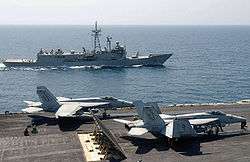Australia–United States relations
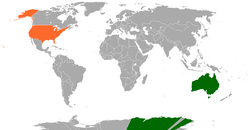 | |
Australia |
United States |
|---|---|
| Diplomatic Mission | |
| Australian Embassy, Washington, D.C. | United States Embassy, Canberra |
| Envoy | |
| Ambassador Joe Hockey | Chargé d'affaires James Carouso |
Australia–United States relations are the international relations between the Commonwealth of Australia and the United States of America. At the governmental level, Australia–United States relations are formalised by the ANZUS treaty and the Australia–United States Free Trade Agreement.
According to a 2014 BBC World Service poll, 44 percent of Australians had a "mainly positive" view of the United States and 46 percent had a "mainly negative" view, for a net rating of −2 points. No similar survey was conducted to ascertain American perceptions of Australia.[1] According to the 2012 U.S. Global Leadership Report, 55% of Australians approve of U.S. leadership, with 21% disapproving and 24% uncertain.[2] In a more recent 2016 Pew Research poll, 60% of Australians approve of U.S. leadership.[3] In 2017, a major poll conducted in Australia by the Lowy Institute showed that 77% believed an alliance with the US was important for security.[4][5] However, the survey showed that 60% of Australians had developed an unfavorable view of the US as a result of President Donald Trump.[6] The survey also showed that the US was no longer considered Australia's "best friend", a title now held by New Zealand.[7] A 2017 survey conducted by the Pew Research Center showed only 29% of Australians had confidence in current US leader President Donald Trump, in contrast to the 87% who had confidence in former US president, Barack Obama.[8] It also showed 70% of Australians had no confidence in the current US president.[9] The annual Lowy Institute survey revealed that in 2018 only 55% of Australians believed that the US could act responsibly in the world.[10] This was a drop from 83% in 2011 and a record low.[10] The survey also revealed that 70% of Australians don't think that Donald Trump could act responsibly with only 30% believing he could do so.[10]
Country comparison
| Coat of Arms |  |
 |
| Flag |  |
 |
| Population | 25,092,600[11] | 324,894,500 |
| Area | 7,692,024 km2 (2,969,907 sq mi) | 9,629,091 km2 (3,717,813 sq mi) |
| Population density | 2.8/km2 (1.74/sq mi) | 34.2/km2 (13.2/sq mi) |
| Government | Federal parliamentary constitutional monarchy | Federal presidential constitutional republic |
| Current leader | Elizabeth II (head of state) Represented by Governor General Peter Cosgrove Scott Morrison (Prime Minister) |
Donald Trump (President)
Mike Pence (Vice President) |
| Main language | English | English |
| Main religions | 52% Christian 30% non-religious 18% other |
74% Christian 20% non-religious 6% other |
| GDP (nominal) | US$1.259 trillion | US$18.569 trillion |
| GDP (nominal) per capita | US$51,850 | US$57,436 |
| GDP (PPP) | $1.137 trillion | $17.528 trillion |
| GDP (PPP) per capita | US$48,899 | $57,436 |
| Real GDP growth rate | 2.50% | 1.80% |
| Military expenditure | $24.48 billion | $640.0 billion |
| Military personnel | 77,399 | 2,927,754 |
Independent foreign policy
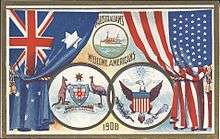
Australian historian Donald Horne, 1964
The political and economic changes wrought by the Great Depression and Second World War, and the adoption of the Statute of Westminster 1931, necessitated the establishment and expansion of Australian representation overseas, independent of the British Foreign & Commonwealth Office. Australia established its first overseas missions (outside London) in January 1940. The first accredited diplomat sent by Australia to any foreign country was B. G. Casey, appointed to Washington in January 1940.[12][13]
The U.S. Embassy opened in Canberra in 1943, constructed in a Georgian architectural style.
Military
In 1908, Prime Minister Alfred Deakin invited the Great White Fleet to visit Australia during its circumnavigation of the world. The fleet stopped in Sydney, Melbourne and Albany. Deakin, a strong advocate for an independent Australian Navy, used the visit to raise the public's enthusiasm about a new navy.
The visit was significant in that it marked the first occasion that a non-Royal Navy fleet had visited Australian waters. Many saw the visit of the Great White Fleet as a major turning point in the creation of the Royal Australian Navy. Shortly after the visit, Australia ordered its first modern warships, a purchase that angered the British Admiralty.[14]
During World War II, U.S. General Douglas MacArthur was appointed Supreme Commander of the Allied Forces in the South West Pacific Area, which included many Australian troops.[15] MacArthur's headquarters were located in Brisbane until 1944 and Australian forces remained under MacArthur's overall command until the end of World War II. After the Guadalcanal Campaign, the 1st Marine Division was stationed in Melbourne, and Waltzing Matilda became the division's march.
ANZUS
After the war, the American presence in the southwest Pacific increased immensely, most notably in Japan and the Philippines. In view of the cooperation between the Allies during the war, the decreasing reliance of Australia and New Zealand on the United Kingdom, and America's desire to cement this post-war order in the Pacific, the ANZUS Treaty was signed by Australia, New Zealand and the United States in 1951.[16] This full three-way military alliance replaced the ANZAC Pact that had been in place between Australia and New Zealand since 1944.
Australia, along with New Zealand, has been involved in most major American military endeavors since World War II including the Korean War, Vietnam War, Gulf War and the Iraq War—all without invocation of ANZUS. The alliance has only been invoked once, for the invasion of Afghanistan after the September 11 attacks on the World Trade Center and The Pentagon.
War on Terror
Following the September 11 attacks, in which eleven Australian citizens were also killed, there was an enormous outpouring of sympathy from Australia for the United States. Prime Minister John Howard became one of President George W. Bush's strongest international supporters, and supported the United States in the invasion of Afghanistan in 2001 and the invasion of Iraq in 2003.
In 2004 the Bush Administration "fast tracked" a free trade agreement with Australia. The Sydney Morning Herald called the deal a "reward" for Australia's contribution of troops to the Iraq invasion.[17][18]
However, Australian Prime Minister Kevin Rudd indicated that the 550 Australian combat troops in Iraq would be removed by mid-2008. Despite this, there have been suggestions from the Australian government that might lead to an increase in numbers of Australian troops in Afghanistan to roughly 1,000.[19]
In 2011, during US President Obama's trip to Australia, it was announced that United States Marine Corps and United States Air Force units will be rotated through Australian Defence Force bases in northern Australia to conduct training. This deployment was criticised by an editorial in the Chinese state-run newspaper People's Daily and Indonesia's foreign minister,[20] but welcomed[20][21] by Australia's Prime Minister. A poll by the independent Lowy Institute think tank showed that a majority (55%) of Australians approving of the marine deployment[22] and 59% supporting the overall military alliance between the two countries.[23]
In 2013, the US Air Force announced rotational deployments of fighter and tanker aircraft through Australia.[24]
Political
.jpg) US and Australian Defence and Foreign Affairs ministers at the AUSMIN summit in Sydney, June 2017.
US and Australian Defence and Foreign Affairs ministers at the AUSMIN summit in Sydney, June 2017. Vice President Pence and Foreign Minister Bishop meet for the first time in the White House, February 2017.
Vice President Pence and Foreign Minister Bishop meet for the first time in the White House, February 2017.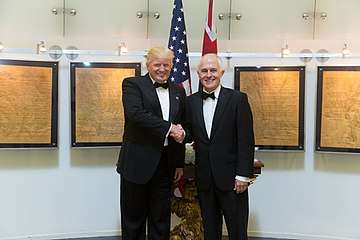 President Trump and Prime Minister Turnbull meet aboard the USS Intrepid to mark the 75th anniversary of the Battle of the Coral Sea, April 2017.
President Trump and Prime Minister Turnbull meet aboard the USS Intrepid to mark the 75th anniversary of the Battle of the Coral Sea, April 2017.
Since 1985, there have been annual ministerial consultations between the two countries, known as AUSMIN. The venue of the meeting alternates between the two countries. It is attended by senior government ministers such as the Australian Minister for Foreign Affairs, Australian Minister for Defence, US Secretary of Defense and US Secretary of State.[25]
Australian tours by U.S. presidents
The first Australian visit by a serving United States President[26] was that of Lyndon B. Johnson in 1966 to seek support for Australia's ongoing involvement in the Vietnam War. Australia had previously sent advisers and combat troops to Vietnam. In 1992, George H. W. Bush was the first of four US presidents to address a joint meeting of the Australian Parliament.
| Dates | President | Cities visited | Reason |
|---|---|---|---|
| 20–23 October 1966 | Lyndon B. Johnson | Canberra, Melbourne, Sydney, Brisbane, Townsville | State visit; met with Governor-General Lord Casey and Prime Minister Harold Holt. First US president to visit Australia.[27] |
| 21–22 December 1967 | Lyndon B. Johnson | Melbourne | Attended memorial service for Prime Minister Harold Holt and conferred with other attending heads of state. |
| 31 December 1991 – 3 January 1992 |
George H. W. Bush | Sydney, Canberra, Melbourne | Met with Prime Minister Paul Keating and senior Australian officials; addressed a joint meeting of the Australian Parliament. |
| 19–23 November 1996 | Bill Clinton | Sydney, Canberra, Port Douglas | State visit. Addressed joint meeting of Parliament and visited the Great Barrier Reef. |
| 22 October 2003 | George W. Bush | Canberra | Met with Prime Minister John Howard and addressed joint meeting of Parliament. |
| 2–5 September 2007 | George W. Bush | Sydney | Asia-Pacific Economic Cooperation (APEC) Conference. |
| 16–17 November 2011 | Barack Obama | Canberra, Darwin | Met with Prime Minister Julia Gillard and addressed joint meeting of Parliament. |
| 15–16 November 2014 | Barack Obama | Brisbane | G20 economic summit. |
United States tours by Australian Prime Ministers
| Dates | Prime Minister | Cities/countries visited | Reason |
|---|---|---|---|
| April and May 1944[28] | John Curtin | San Francisco, Washington, Warm Springs, New York City | Meeting with President Roosevelt and travel to and from the Commonwealth Prime Ministers' Conference in London. |
| 9 May 1946[29] | Ben Chifley | Washington | Met with President Truman for 15 minutes. |
| 28 July 1950[30] | Robert Menzies | Washington | Met with President Truman for half the day. |
| 19 May 1952[30] | Robert Menzies | Washington | Met with President Truman. |
| 20 December 1952[30] | Robert Menzies | Washington | Met with President Truman for informal dinner. |
| 2 October 1960[31] | Robert Menzies | Washington | Met with President Eisenhower and Prime Minister Harold MacMillan of the United Kingdom. |
| 24 February 1961[32] | Robert Menzies | Washington | Met with President John F. Kennedy and discussed SEATO, ANZUS and Laos. |
| 20 June 1962[32] | Robert Menzies | Washington | Met with President Kennedy and discussed West New Guinea, Vietnam, ANZUS and the European Union. |
| 8 July 1963 [33] | Robert Menzies | Washington | Met with President Kennedy. |
| 24 June 1964[34] | Robert Menzies | Met with President Lyndon B. Johnson. | |
| 7 June 1965[35] | Robert Menzies | Met with President Johnson. | |
| June 1966[36] | Harold Holt | Met with President Johnson and endorsed the USA's Vietnam policy. His speech included the words "All the way with LBJ". | |
| 27 to 30 May 1968 [37] | John Gorton | Washington and LBJ ranch | Met with President Johnson and discussed Vietnam. |
| 6 May 1969 [38] | John Gorton | Washington | Met with President Richard Nixon and discussed Vietnam. |
| 2 November 1971 [39] | William McMahon | Washington | Met with President Nixon and discussed bilateral issues and commitment to the ANZUS treaty. |
| NA[40] | Gough Whitlam | No visit. Nixon had not extended an invitation due to irritation over a letter from Whitlam criticising bombing in North Vietnam. Whitlam was prepared to visit in June 1973 without an official invitation ("Official invitations are not necessary in these circumstances").[41] | |
| 27 July 1977[42] | Malcolm Fraser | Met with President Jimmy Carter. | |
| 30 June 1981[43] | Malcolm Fraser | Met with President Ronald Reagan. | |
| 17 April 1986[44][45] | Bob Hawke | US/Australian relations | Met with President Reagan. US offered a $5M gift for Australia's bicentennial celebrations for the proposed Australian Maritime Museum.[46] |
| 22–24 June 1988[45] | Bob Hawke | Washington, D.C. | Met with President Reagan and other government officials. |
| 14 September 1993[47] | Paul Keating | Seattle, Washington | APEC meeting - met with President Bill Clinton. |
| 7–15 July 2000[48] | John Howard | Japan and USA | |
| 4–8 September 2000[49][50] | John Howard | Millennium Summit and Commonwealth High Level Review Group. | |
| 8–14 June 2001[51] | John Howard | ||
| 8–14 September 2001[51] | John Howard | State visit. Address a joint sitting of the US Congress on 12 September. Was the first world leader to support the USA in its response to the September 11 attacks. | |
| 28 January – 8 February 2002[51] |
John Howard | ||
| 8–16 February 2003[52] | John Howard | ||
| 1–10 May 2005[53] | John Howard | New York City, Washington, D.C. | State visit. Addressed the 60th anniversary session of the United Nations in New York City. |
| 8–14 May 2006[54] | John Howard | ||
| March/April 2008[55] | Kevin Rudd | Washington DC | Part of 17-day world tour to China, the US, the UK and Europe. Met with President George W. Bush, Secretary of State Condoleezza Rice, Defense Secretary Robert Gates and US Federal Reserve Chairman Ben Bernanke.[56] Also met with several presidential candidates.[57] |
| 24 March 2009 | Kevin Rudd | Washington DC | Met with President Barack Obama. |
| 7 March 2011 | Julia Gillard | Washington DC | Met with President Barack Obama and addressed joint sitting of Congress. |
| 12–13 November 2011 | Julia Gillard | Honolulu, Hawaii | APEC meeting - met with President Barack Obama. |
| 24–28 September 2012[58] | Julia Gillard | New York City | Addressed the 67th session of the United Nations in New York City. |
| 12 June 2014 | Tony Abbott | Washington DC | Met with President Barack Obama. |
| 19 January 2016 | Malcolm Turnbull | Washington DC | Met with President Barack Obama. |
| 4 May 2017 | Malcolm Turnbull | New York City | Met with President Donald Trump. |
| 23 February 2018 | Malcolm Turnbull | Washington DC | Met with President Donald Trump. |
Kyoto Protocol
Australia's Prime Minister, Kevin Rudd, ratified the Kyoto Protocol on 3 December 2007, leaving the United States and Canada as the last major industrial nations not to ratify the agreement.[19] Australia's previous government, led by Liberal John Howard, refused to ratify the Kyoto Protocol citing, along with the United States, that it would "damage their economies".[59]
Trump administration
During the first phone conversation between American President Donald Trump and Australian Prime Minister Malcolm Turnbull, that took place in February 2017 and lasted around 25 minutes,[60] Trump disagreed with Turnbull on a deal made during President Barack Obama's presidency. The agreement aims to take about 1,250 asylum seekers into the United States, who are currently located on Nauru and Manus Island by Australian authorities.[61] The deal will involve a swap of the 1,250 refugees located on Nauru and Manus with several thousand refugees originating in Honduras, Guatemala, and other Central American nations. Though the details of the trade were not made transparent to the public, a public briefing announced the deal would be applied only to existing refugees and that they would be resettled in America in the coming year.[62][63]
On Twitter, February 2, 2017, Trump tweeted that the refugee agreement was a "dumb deal".[64] Notwithstanding the disagreement, Vice President Mike Pence, while on a visit to Australia in April 2017, stated the United States will abide by the deal.[65] In August 2017, the Washington Post released the full transcript of the meeting. In it, President Trump described the refugee deal as "ridiculous", "rotten", and "stupid". The President, angered by the discussion about refugees, said "I have had it. I have been making these calls all day and this is the most unpleasant call all day. Putin was a pleasant call".[66]
In a video released by Channel Nine on 14 June 2017, Turnbull is seen mocking Trump at the Midwinter Ball.[67]
In response to the growing threat of North Korea developing nuclear intercontinental ballistic missiles, Prime Minister Turnbull, in August 2017, emphasized the alliance between Australia and the United States and his nation's commitment to aiding the United States with possible conflict stating, "So be very, very clear on that. If there's an attack on the US, the ANZUS Treaty would be invoked and Australia would come to the aid of the United States, as America would come to our aid if we were attacked."[68]
In May 2018, the United States granted Australia a permanent exemption from the United States' worldwide 25% steel tariff, making Australia one of only four nations worldwide to be exempted.[69] Several other countries generally considered to have close relationships with the United States, such as Canada, Mexico, and the European Union, have not received permanent exemptions.
Trade

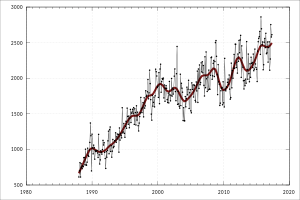
Trade between the United States and Australia is strong, as evidenced by the Australia–United States Free Trade Agreement. The United States is Australia’s fourth largest export market and its second largest source of imports.[70] The United States is also the largest investor in Australia while Australia is the fifth largest investor in the US.
Australia and the United States also provide significant competition for each other in several third-party exports such as wheat, uranium and wool and, more recently, in the information technology sector. Although the US has a sizable sheep population, American imports of lamb meat from Australia and New Zealand remain stronger than the domestic output.
See also
- Australian Americans
- Australian–American Memorial
- Foreign relations of Australia
- Embassy of Australia, Washington, D.C.
- Foreign relations of the United States
- Friends of Australia Congressional Caucus
- Quadrilateral Security Dialogue
- U.S./Australia Parliamentary Friendship Group
- USS Canberra (CA-70)
- USS Canberra (LCS-30)
References
Inline
- ↑ "Negative views of Russia on the Rise: Global Poll" (PDF). BBC World Service. 3 June 2014. p. 31. Retrieved 15 June 2017.
- ↑ U.S. Global Leadership Project Report - 2012 Gallup.
- ↑ "1. America's international image". 28 June 2016.
- ↑ "Why Australians are feeling down in the dumps".
- ↑ "Australians May Not Like Trump, But They Value the U.S." 21 June 2017 – via www.bloomberg.com.
- ↑ "New poll suggests Trump causes Australians to form unfavourable view of US".
- ↑ "Aussies name NZ as their new 'best friend' as Uncle Sam's allure fades". 21 June 2017 – via www.nzherald.co.nz.
- ↑ "U.S. Image Suffers as Publics Around World Question Trump's Leadership". 26 June 2017.
- ↑ "2. Worldwide, few confident in Trump or his policies". 26 June 2017.
- 1 2 3 "Donald Trump a 'critical threat' to Australia's interests as trust in US hits record low, Lowy survey reveals". 20 June 2018.
- ↑ "Population clock". Australian Bureau of Statistics website. Commonwealth of Australia. Retrieved 15 December 2016. The population estimate shown is automatically calculated daily at 00:00 UTC and is based on data obtained from the population clock on the date shown in the citation.
- ↑ F. K. Crowley, ed., Modern Australia in Documents: 1939-1970 (1973) 2: 12-14.
- ↑ Roger John Bell, Unequal allies: Australian-American relations and the Pacific war (Melbourne University Press, 1977).
- ↑ Macdougall, A (1991). Australians at War: A Pictorial History. Noble Park, Victoria: The Five Mile Press. p. 360. ISBN 1-86503-865-2.
- ↑ Naval Historical Society of Australia. "On This Day - 1942". Naval Historical Society of Australia. Retrieved 26 June 2012.
- ↑ Full text of the ANZUS Treaty Archived 16 February 2008 at the Wayback Machine.
- ↑ "President Bush Signs U.S.-Australia Free Trade Agreement". 3 August 2004. Retrieved 28 April 2016.
- ↑ "US House approves free trade pact". The Sydney Morning Herald. 15 July 2004.
- 1 2 Reynolds, Paul (26 November 2007). "Australia shifts course, away from US". BBC News. Archived from the original on 6 April 2008. Retrieved 3 April 2008.
- 1 2 Packham, Ben (17 November 2011). "China reproaches Australia over strengthened US defence ties". The Australian.
- ↑ "Obama visit: Australia agrees US Marine deployment plan". BBC. 16 November 2011.
- ↑ "2011 Lowy Institute Poll". Lowy Institute.
- ↑ "Australians happy hosting U.S. troops". High Beam Research.
- ↑ "AF to Add Fighter, Bomber Rotations to Australia". Military.com. Retrieved 28 April 2016.
- ↑ "2005 Australia-United States Ministerial Consultations Joint Communique". Australian Government Department of Foreign Affairs and Trade. Retrieved 10 December 2006.
- ↑ "Australia". US Department of State. Archived from the original on 9 November 2006. Retrieved 12 November 2006.
- ↑ "Harold Holt - Australia's PMs - Australia's Prime Ministers". Primeministers.naa.gov.au. Archived from the original on 17 September 2010. Retrieved 22 August 2010.
- ↑ "John Curtin: In office". Australia's Prime Ministers. National Archives of Australia. Retrieved 21 November 2011.
- ↑ "Daily Presidential Appointments". Truman Library. 9 May 1946. Retrieved 22 August 2010.
- 1 2 3 "Daily Presidential Appointments". Truman Library. 28 July 1950. Retrieved 22 August 2010.
- ↑ "Dwight D. Eisenhower: Joint Statement following Meeting With Prime Minister Macmillan and Prime Minister Menzies". Presidency.ucsb.edu. 2 October 1960. Retrieved 22 August 2010.
- 1 2 "John F. Kennedy: Joint Statement following Discussions With Prime Minister Menzies of Australia". Presidency.ucsb.edu. 20 June 1962. Retrieved 22 August 2010.
- ↑ "John F. Kennedy: Toasts of the President and Prime Minister Menzies of Australia". Presidency.ucsb.edu. 8 July 1963. Retrieved 22 August 2010.
- ↑ "Lyndon B. Johnson: Toasts of the President and Prime Minister Menzies of Australia". Presidency.ucsb.edu. 24 June 1964. Retrieved 22 August 2010.
- ↑ "Lyndon B. Johnson: The President's Toast at a Luncheon in Honor of Sir Robert Menzies, Prime Minister of Australia". Presidency.ucsb.edu. 7 June 1965. Retrieved 22 August 2010.
- ↑ "Prime Ministers of Australia: Harold Holt". National Museum of Australia. Retrieved 22 August 2010.
- ↑ "Lyndon B. Johnson: Toasts of the President and Prime Minister Gorton of Australia". Presidency.ucsb.edu. 27 May 1968. Retrieved 22 August 2010.
- ↑ "Richard Nixon: Toasts of the President and Prime Minister John G. Gorton of Australia". Presidency.ucsb.edu. 6 May 1969. Retrieved 22 August 2010.
- ↑ "Richard Nixon: Remarks Following a Meeting With Prime Minister William McMahon of Australia". Presidency.ucsb.edu. 2 November 1971. Retrieved 22 August 2010.
- ↑ "Timeline - Australia's Prime Ministers". Primeministers.naa.gov.au. Archived from the original on 11 August 2010. Retrieved 22 August 2010.
- ↑ "The Milwaukee Journal - Google News Archive Search". Retrieved 28 April 2016.
- ↑ "7/27/76 - Remarks During Arrival Ceremony of Prime Minister J. Malcolm Fraser of Australia". Research.archives.gov. Retrieved 17 September 2016.
- ↑
- ↑ "NSDD – National Security Decision Directives – Reagan Administration". Federation of American Scientists. Archived from the original on 11 December 2006. Retrieved 11 December 2006.
- 1 2 "Visit of Australian Prime Minister – Robert J.L. Hawke and Ronald Reagan address – transcript". US Department of State Bulletin. September 1988. Retrieved 27 November 2006.
- ↑ "U.S./Australian Relations (NSC-NSDD-229)". Federation of American Scientists. Retrieved 11 December 2006.
- ↑ "William J. Clinton: The President's News Conference With Prime Minister Paul Keating of Australia". Presidency.ucsb.edu. 14 September 1993. Retrieved 22 August 2010.
- ↑ "Annual Report 1999-2000" (PDF). Department of Prime Minister and Cabinet. 2000. Archived from the original (PDF) on 9 December 2006. Retrieved 27 November 2006.
- ↑ "Annual Report 2001-01" (PDF). Department of Prime Minister and Cabinet. 2001. Archived from the original (PDF) on 5 October 2006. Retrieved 27 November 2006.
- ↑ "Media release: Visit to New York". Prime Minister of Australia. 18 August 2000. Archived from the original on 3 October 2006. Retrieved 27 November 2006.
- 1 2 3 "Annual Report 2001-02" (PDF). Department of Prime Minister and Cabinet. 2002. Archived from the original (PDF) on 10 December 2006. Retrieved 27 November 2006.
- ↑ "Annual Report 2002-03" (PDF). Department of Prime Minister and Cabinet. 2003. Archived from the original (PDF) on 11 December 2006. Retrieved 27 November 2006.
- ↑ "Annual Report 2005-06" (PDF). Department of Prime Minister and Cabinet. 2006. Archived from the original (PDF) on 30 August 2007. Retrieved 27 November 2006.
- ↑ "President Bush Welcomes Prime Minister John Howard of Australia to the White House". www.whitehouse.gov. Retrieved 9 November 2007.
- ↑ Mark Kenny (27 March 2008). "American alliance still strong ahead of Kevin Rudd's world tour". Herald Sun.
- ↑ "Kevin Rudd goes global". SMH. 28 March 2008.
- ↑ "Rudd to meet White House hopefuls". ABC. 31 March 2008.
- ↑ "Julia Gillard attends UN opening in New York as Security Council vote looms". News.com.au. 26 September 2012.
- ↑ Black, Richard (27 July 2005). "New climate plan 'to rival Kyoto'". BBC News. Retrieved 4 April 2008.
- ↑ Karp, Paul (3 February 2017). "'Big personality': Australian PM puts brave face on phone call with Trump". The Guardian. ISSN 0261-3077. Retrieved 7 February 2017.
- ↑ Jake Tapper, Eli Watkins, Jim Acosta and Euan McKirdy. "Trump has heated exchange with Australian leader, sources say". CNN. Retrieved 7 February 2017.
- ↑ "PM unveils 'one-off' refugee resettlement deal with US". Australian Broadcasting Corporation. 13 November 2016.
- ↑ "Manus, Nauru one-off resettlement deal with US confirmed". The Australian. 13 November 2016.
- ↑ Sydney, Katharine Murphy Ben Doherty in (2 February 2017). "Australia struggles to save refugee agreement after Trump's fury at 'dumb deal'". The Guardian. ISSN 0261-3077. Retrieved 7 February 2017.
- ↑ "US 'will honour' refugee deal with Australia that Trump called 'dumb'", retrieved April 29, 2017.
- ↑ March, Stephanie (4 August 2017). "Donald Trump told Malcolm Turnbull 'you are worse than I am' on refugees during call, leaked transcript reveals". ABC News (Australia). ABC. Retrieved 4 August 2017.
- ↑ Westcott, Ben (15 June 2017). "Australia's Turnbull mocks US President Trump in leaked audio". CNN. Retrieved 15 June 2017.
- ↑ "North Korea: Australia would support United States in conflict, Malcolm Turnbull says - ABC News (Australian Broadcasting Corporation)". mobile.abc.net.au. Retrieved 2017-10-02.
- ↑ "Trump to exempt Australia from steel and aluminium tariffs". SBS News. Retrieved 1 October 2018.
- ↑ "Archived copy" (PDF). Archived from the original (PDF) on 2 October 2008. Retrieved 27 September 2008.
General
- "Background Note: Australia" U.S. Department of State. August 2006. 11 October 2006
- "Ancient Heritage, Modern Society" Australian Government, Department of Foreign Affairs and Trade. May 2005. 11 October 2006
- Dalton, John. Lecture. Bond University. Australian Culture From an International Perspective. Bond University, Gold Coast, Queensland. Fall 2005.
- "Australia-United States Free Trade Agreement" Australian Government. 2005. 28 October 2006
- "The Australian Continent" Australian Government. 2005. 28 October 2006.
External links
| Wikimedia Commons has media related to Australia – United States relations. |
